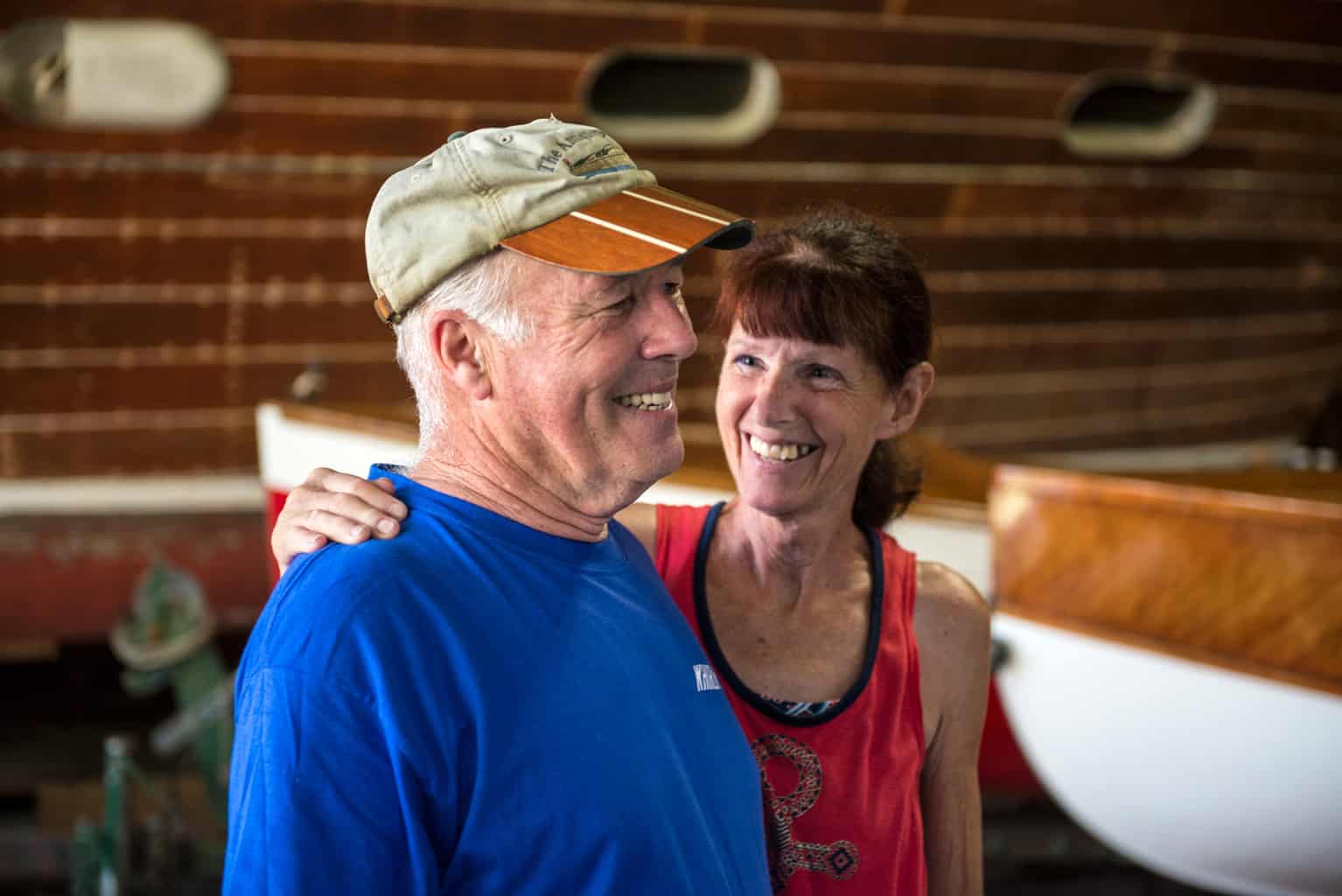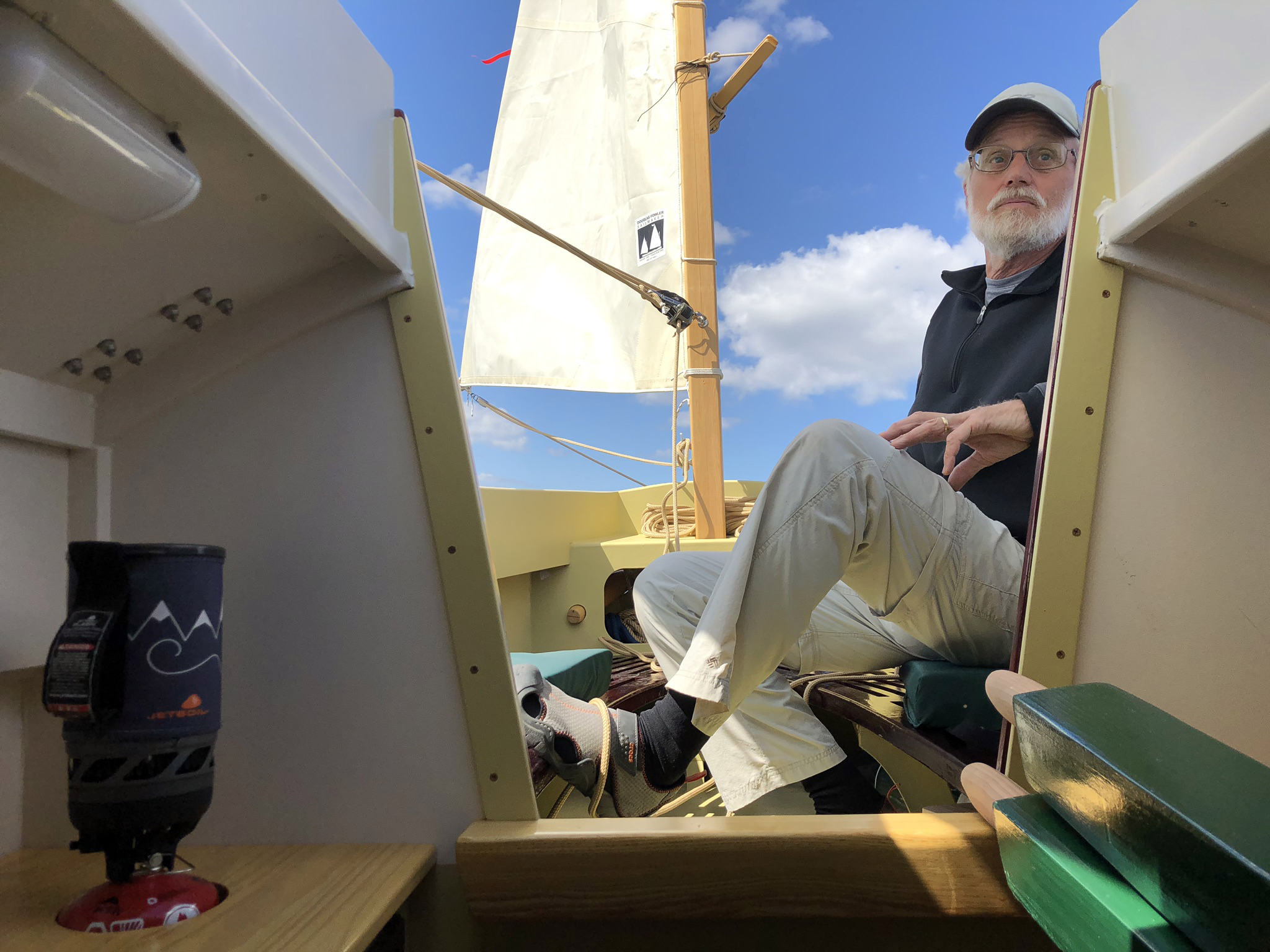by Wendy Mitman Clarke
Bill Museler is tidying up his Herreshoff 12 ½, Raven, in the annex of the Annapolis Yacht Club when I walk up with my sister-in-law, Cindy Weber, who is bearing bottles of cold water. The race had only lasted maybe half an hour, but it was stifling hot, humid and shifty as always on a light-air summer evening in Annapolis harbor. The race had been hard-fought, if slowly. And with Cindy at the helm of her 12 ½, Hubcap, and me trimming, we had pretty much rocked it, recovering from a rough start to overtake the fleet (well, four other boats) and get the gun (well, horn).
“You just kept coming,” Museler says to Weber, shaking his head, as she hands him a bottle of water. “That boat is fast, Cindy.” Museler, the captain of the Annapolis Herreshoff 12 ½ fleet, typically sails with his wife, Maria. Though this evening, says Museler, she “only watched our glorious start, not our inglorious finish.”

Fast is, of course, relative, and when talking about Wednesday racing at AYC, or any racing out of Annapolis really, fast can mean serious speed. Along with the many recreational racers, Wednesdays are a good time for the hotly competitive teams to shake it out a little,
get to know new boats and new designs, play with sail selection, scope the competition. Annapolis has long been a sailboat racing mecca, and for many, it doesn’t matter what you bring to the starting line, as long as you race well and sail fast. And though the Herreshoff fleet is small, only about half-dozen boats or so at the moment, the boats are drawn from a design that’s over 100 years old, and their top speed in flat water on a screaming reach is, oh, say 5–6 knots. But that does not mean the men, women, and children who sail them are any less devoted to their sport or their boats. They’re competitive too, although it’s a slow-glowing ember, rather than a
white-hot flame.
“It’s a very friendly competition,” says Chuck Hurley, who owns and races Bit O’ Luck. “Has there ever been a contested race?”
“No, we outlawed all protests,” says Museler. And, there are other deviations from the usual rules that bind faster, sportier boats. For instance, Museler notes that if the wind is just too shifty for a really good race, the first boat to the weather mark has the right to shorten the course, calling out the change to the other boats as he or she rounds the mark. The Annapolis fleet allows hiking sticks on the tillers, as well as battens in the jibs. They are tolerant enough to allow Hubcap, which is Bermuda-rigged, to race with the other traditionally gaff-rigged boats. And while the class rules dictate two persons per boat, it’s not unusual for the Annapolis boats to be loaded with grandkids, dogs, or all manner of other crew.
In some respects, the egalitarian nature of the Annapolis fleet pays tribute in the finest way to the roots of this beautiful little boat, which was designed in 1914 by Captain Nathanael Herreshoff at the behest of one Robert W. Emmons II. Emmons wanted a quick but stout small boat for children to learn on while sailing the frequently choppy and windy Buzzards Bay in Massachusetts. At 15 feet length overall, with a commodious beam of 5 feet 10 inches, a full keel drawing only 2 feet 6 inches, a stout 1,500 pounds displacement and a healthy sail area of 140 square feet—the vast majority of it in the gaff-rigged mainsail—the new boat was stable, seakindly and pugnaciously graceful.
“It is unlikely that in 1914 or 1915 the genius of Nathanael G. Herreshoff or the inspiration of Mr. Emmons could have foretold the unique popularity and longevity of the design we have now seen for nearly 100 years,” reads a history on the website of the H Class Association. “She is still considered to be one of the finest, if not the finest, small sailing yacht designs ever created. As it turned out, the boat was perfect for all ages in the family, not just the kids.”


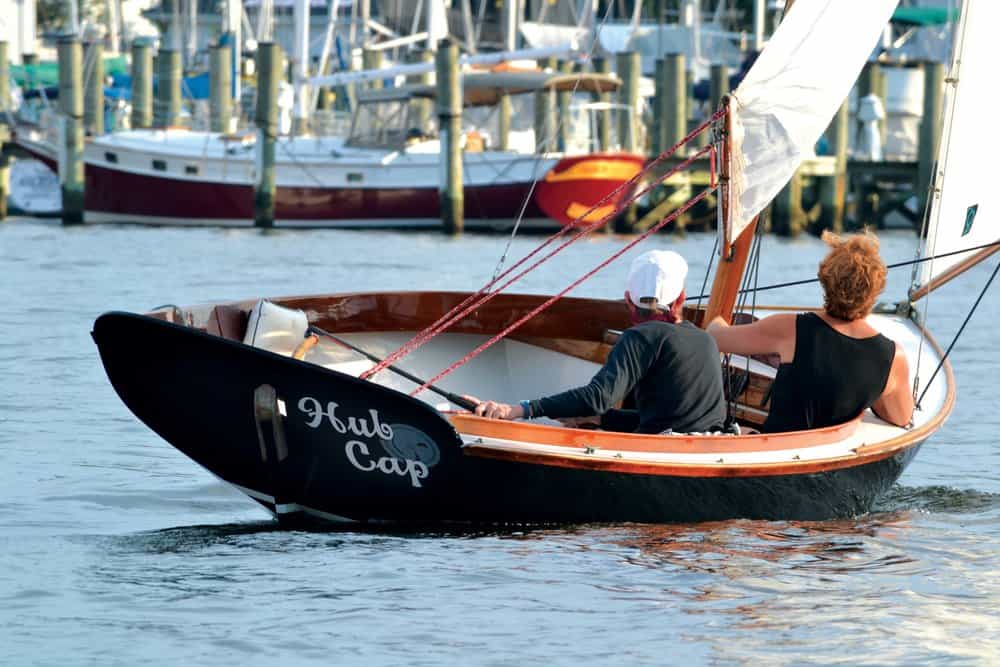
That first year, Herreshoff Manufacturing produced 20 of the new boats, starting with hull No. 1, Robin, and continuing with names like Elf, Shrimp, Junco, Kinglet, Chub, Nettle, and my personal favorite, Door Mouse. Robin has been restored and is on display in the Herreshoff Museum in Bristol, R.I. In places like Beverly, Mass., the 12 ½ has been a racing class since the beginning and is
still going strong.
“Today the H Class can boast growing racing fleets of H12s from way up north in Maine, to farther south in Annapolis,” association President George Moffatt of the Beverly Yacht Club wrote in his 2016 letter to the class.
“And as more sailors discover us online, we are hearing from H Class boatowners far and wide, and can verify that there are boats sailing in 19 states, and in England, France and Norway. In fact, just recently we received a letter and photographs from the owners of Angelina, who sail her on a beautiful lake in Idaho—7,000 feet above sea level!”
In Annapolis, the fleet began in the 1980s when the late Arnie Gay, a marina owner and renowned yachtsman, brought hull No. 14 here and restored it, according to a 1996 article in Inside Annapolis magazine, quoted in the AYC newsletter. Gay convinced some fellow sailors to buy their own, and over time, the fleet has waxed and waned but has consistently drawn new owners. Many of them are older sailors who have raced in the past and want to take it a little easier; others are new to the boats and racing.
“We’re always looking for slow sailors,” jokes Hurley, who had a sailboat for 30 years and now cruises on a trawler, racing Bit O’ Luck just for fun. He frequently sails with his 10-year-old grandson, Cory Van Riper, and Terry Otis, a former Beetle Cat sailor who works for Chesapeake Light Craft. “In four knots of wind we can get up to three-and-a-half, and in thirty knots of wind we can get to four-and-a-half.”
Museler grew up sailing a West Indies 36 and then raced with his kids on a J/22 “until my kids threw me off.” He bought Raven 11 years ago, and he and his wife Maria enjoy it because the racing is less stressful and “easier on the back.”
Spencer Leech, who owns Blue Jacket, had sailed on one of the boats before in Edgartown, Mass., and in Annapolis with Mike Ashford, who was one of the early owners. He came by Blue Jacket in a unique and bittersweet fashion; her owner, the late Arthur Edwards, was Leech’s boss who asked him to sail the boat for him when he couldn’t anymore.
“I never saw him sail the boat, but he would sit up at the yacht club and watch me sail,” Leech says. “When he died, he gave the boat to me.” Ordinarily Leech sails with his fiancée, and it’s the ease of the boat and the laid-back atmosphere that makes it so worthwhile.
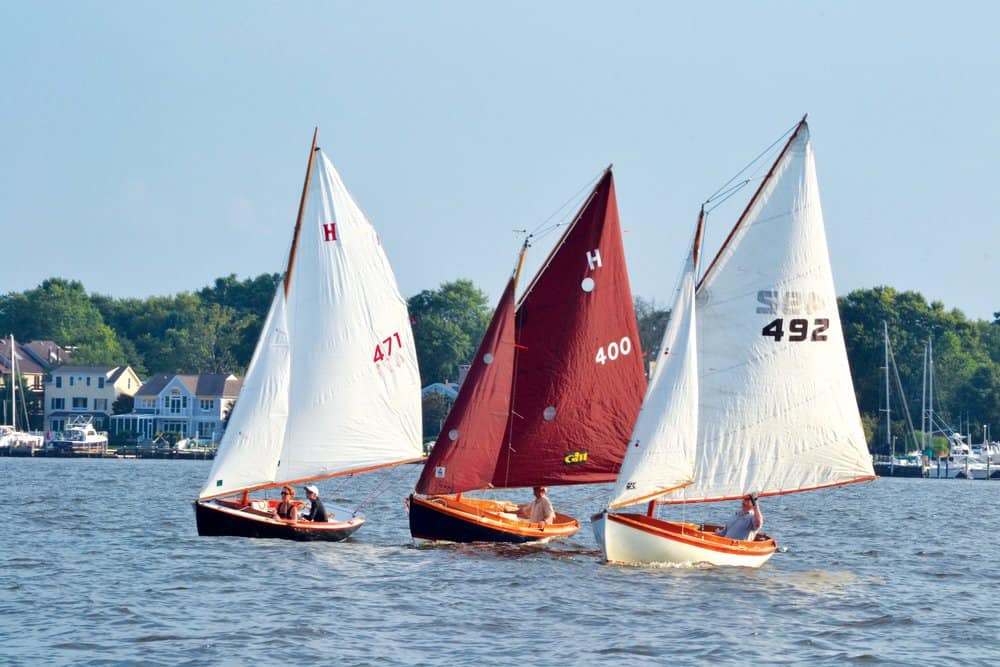
“We can come down, the two of us, put the boat in the water, go around the buoys, and then go out for dinner. It means we’re out on the water every Wednesday night. It’s easy.”
Cindy Weber, who grew up sailing on Weems Creek and the Severn River but was never big into racing, saw the H12s sailing in Spa Creek and on the river and thought it would be a great improvement on her Laser, which was cantankerous and physical most of the time, rather than a pleasant sailing platform.
“I thought, that is the kind of boat I need. I could go by myself or I could take people,” she says. She bought her boat in 2004 and started sailing on her own and sometimes with her husband, John, on the river just for fun. Along the way, John urged her to get involved with the AYC fleet, and her friend and neighbor Maureen Walsh was all about crewing. Their biggest booster, John, frequently watches the races and enjoys kitting the ladies up in Hubcap swag, including team hats and shirts.
Along with the Wednesday night series, the group hosts a one-day fall and spring regatta. In typical playful fashion, whoever wins is required to host the regatta party the following year. But don’t let that playfulness fool you entirely. With the depth of experience many of these sailors possess, and the inherent toughness and stability of Captain Nat’s remarkably resilient design,
they will race in the same conditions as the big boats, and sail just as hard. They’ll just be doing it with a lot more style.
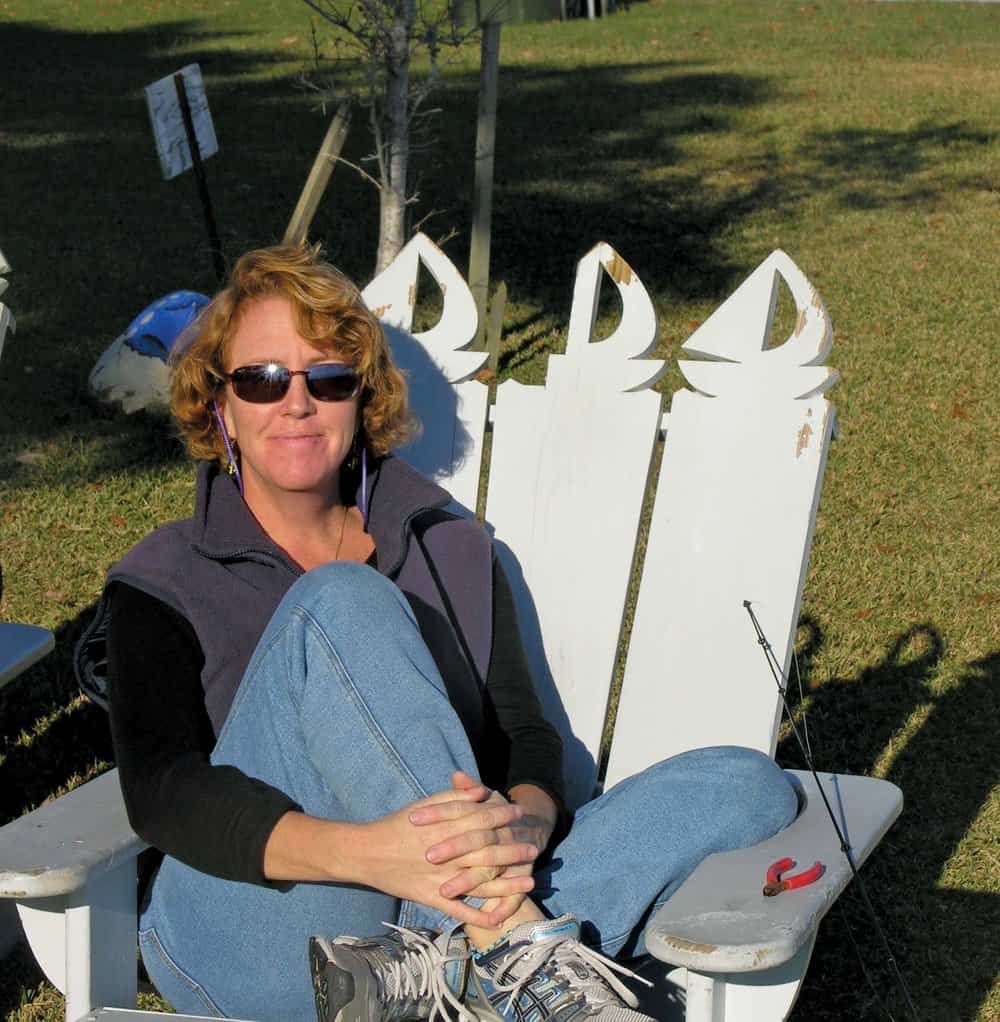
“This is the most classic daysailer in America,” says Terry Otis, laying an affectionate hand on the graceful sheer of Bit O’ Luck. “This is it.”


